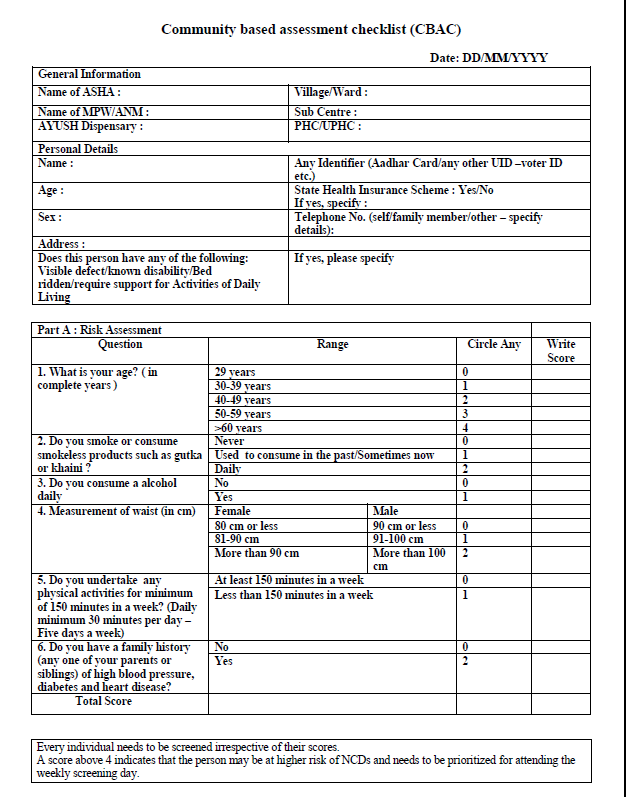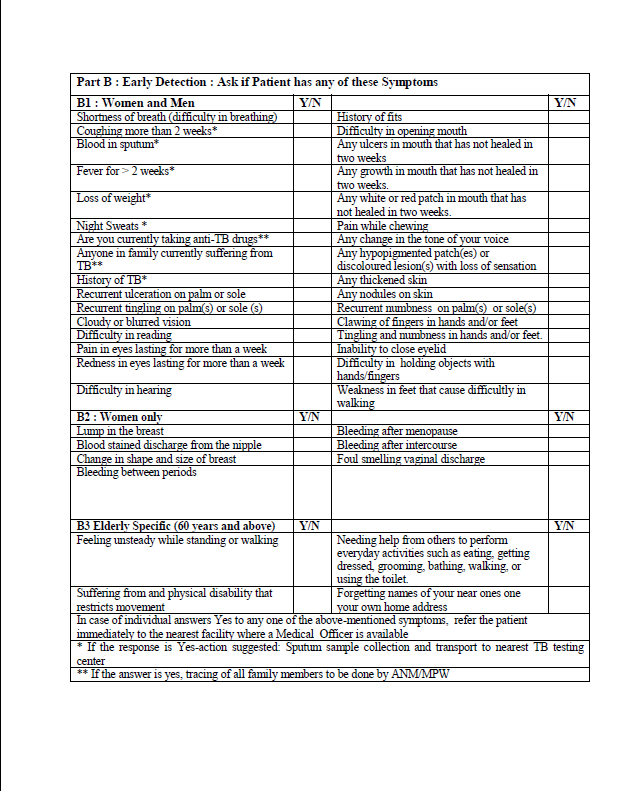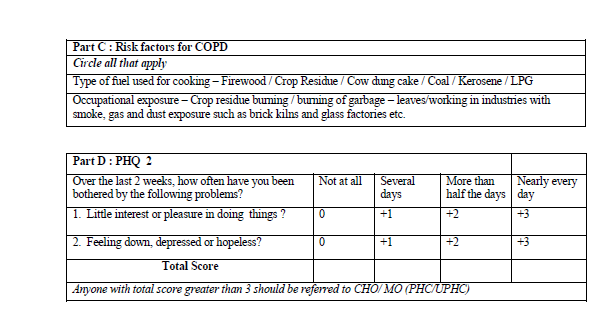Content Status
Type
Linked Node
Community-Based Assessment Checklist [CBAC] Form for Early Detection of NCDs and Tuberculosis
Learning ObjectivesCBAC Form in early detection of Non-Communicable Diseases (NCDs) and Tuberculosis (TB) in communities
Community-Based Assessment Checklist (CBAC) Form is an essential tool used for the early detection of Non-Communicable Diseases (NCDs) and Tuberculosis (TB) in communities. NCDs are chronic diseases that are not contagious and are caused by a combination of genetic, environmental, and lifestyle factors. These diseases include cardiovascular diseases, diabetes, cancer, and chronic respiratory diseases. TB, on the other hand, is an infectious disease caused by bacteria that primarily affect the lungs. It is transmitted through the air when an infected person coughs, sneezes or speaks.
The CBAC form is designed to help community health workers and other healthcare professionals identify individuals at risk of NCDs and TB in the community. The form contains a checklist of questions that cover different aspects of an individual's health, such as lifestyle habits, medical history, and symptoms of NCDs and TB. The CBAC form is an effective tool because it is simple to use, can be administered by non-medical personnel, and can be used in low-resource settings.
The CBAC form consists of three sections. The first section covers general demographic information such as name, age, sex and address. The second section covers lifestyle habits such as smoking, alcohol consumption, physical activity, and diet. These are important factors in the development of NCDs and TB. The third section covers medical history and symptoms related to NCDs and TB. It includes questions about the presence of chronic diseases such as diabetes, COPD and mental health issues as well as symptoms such as cough, fever, night sweats and weight loss.
The CBAC form is used in community-based screenings where healthcare workers go into the community to screen individuals for NCDs and TB. The screenings are conducted in various settings, such as workplaces, schools, and community centers. The form is administered to individuals who meet the screening criteria, which vary depending on the disease being screened for. For example, individuals over the age of 40 are at higher risk of developing NCDs and are therefore more likely to be screened for these diseases. There are questions specific to screening women's medical problems and the medical issues of the elderly.
The CBAC form has several advantages. Firstly, it is a low-cost and effective tool for early detection of NCDs and TB in the community. It can be administered by non-medical personnel and can be used in low-resource settings where access to medical services is limited. Secondly, the form is simple to use and can be completed in a short amount of time. This makes it easy to administer in large-scale community screenings. Finally, the CBAC form can be used to track the prevalence of NCDs and TB in the community over time. This information can be used to plan and implement public health interventions to prevent and control these diseases.
The CBAC form is an important tool in the fight against NCDs and TB, as it helps to identify individuals who are at risk of developing these diseases. Early detection is key to preventing and controlling NCDs and TB, and the CBAC form plays a critical role in achieving this goal.



Resources
Assessment
| Question | Answer 1 | Answer 2 | Answer 3 | Answer 4 | Correct answer | Correct explanation | Page id | Part of Pre-test | Part of Post-test |
| What does the second section of the CBAC form deal with? | Medical history and symptoms | Lifestyle habits | Demographic information | Mental health | 2 | The second section covers lifestyle habits such as smoking, alcohol consumption, physical activity, and diet. These are important factors in the development of NCDs and TB. | |||
| Which of the following statements are true about the CBAC form? | CBAC form is a low-cost and effective tool | It is used for the early detection on NCDs and TB | It can be used only by medical experts | It is short so it can be used for large scale community screenings. | 3 | It can be administered by non-medical personnel and can be used in low-resource settings where access to medical services is limited. |
Content Creator
Reviewer
- Log in to post comments